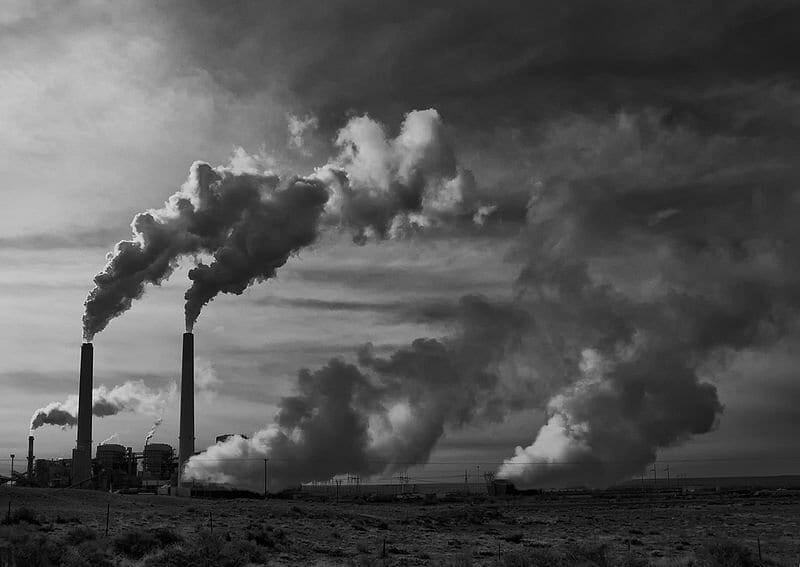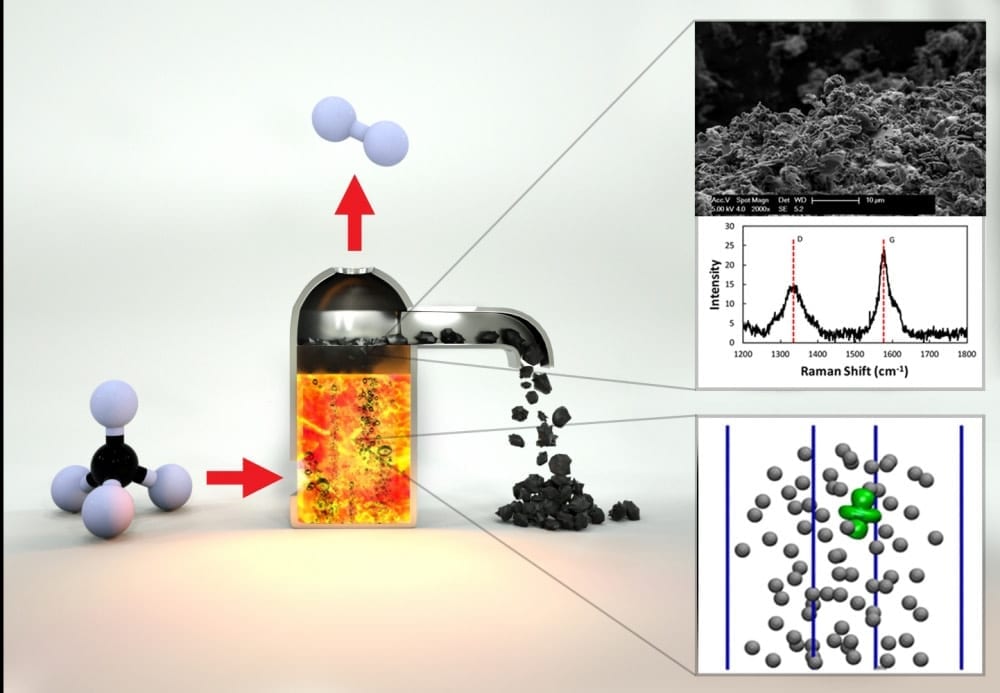
Dutch scientists have a use for all the carbon dioxide that pours from the chimneys of fossil fuel-burning power stations: Harvest it for even more electricity
Power-generating stations worldwide release 12 billion tons of carbon dioxide every year as they burn coal, oil or natural gas; home and commercial heating plants release another 11 billion tons. A team of Dutch scientists has a use for it.
Power plants could, they argue, pump the carbon dioxide through water or other liquids and produce a flow of electrons – and therefore more electricity.
This would be enough, they argue, to create 1,750 terawatt hours of extra electricity annually – about 400 times the output of the Hoover Dam in the Nevada – and all without adding an extra gasp of carbon dioxide into the atmosphere. The exhaust from one cycle of electricity production could be used immediately to deliver another flow of power to the grid.
They make the claim in the journal Environmental Science and Technology Letters, published by the American Chemical Society. The claim rests on a 200-year-old technique pioneered by Sir Humphry Davy and Michael Faraday: electrolysis.
Behind the reasoning is a simple proposition, namely that every chemical event involves some exchange of energy. In a solution, this movement of energy involves electrons, and ions that migrate to cation or anion electrodes. In a mix of two different solutions, the final mixture has an energy content lower than the sum of the two original solutions. But since energy cannot be created or destroyed, therefore there must be some energy available for exploitation.
Bert Hamelers of Wetsus, a Netherlands-based collaboration between companies and research institutes exploring water technology, and colleagues from Wageningen University report that they used porous electrodes and flushed carbon dioxide into water. They got a flow of current as the gas reacted with water to make carbonic acid, which in the electrolyte became positive hydrogen ions and negative ions of the bicarbonate HCO3. As the pH of the solution rose, the bicarbonate became a simple carbonate; the higher the CO2 pressure, the greater the increase of ions in the solution.
In their experiment, they found that as they flushed their aqueous electrolyte with air, and alternately with CO2, between their porous electrodes, a supply of electricity began to build up. Since the air that comes from the chimneys of fossil fuel-burning power stations contains up to 20 percent of CO2, even the emissions represent a potential for more power.
The Latest Bing News on:
Waste CO2
- Biomass, captured carbon and plastic waste can help 'defossilize' chemicals, report sayson May 8, 2024 at 9:20 am
Policy briefing sets out how industry can move away from fossil fuel feedstocks and embrace low carbon and sustainable alternatives ...
- Photoactive Nanowires Drive Efficient CO2 Conversion in New Photocatalyston May 8, 2024 at 6:11 am
Researchers from Shanghai Jiao Tong developed a new photocatalyst that uses concentrated sunlight to convert methane waste gas and CO2 into syngas, a valuable fuel precursor.
- Towards Carbon Neutrality: New Catalyst Converts Carbon Dioxide to Renewable Fuelon May 8, 2024 at 1:51 am
Researchers at the University of Michigan have developed a catalyst material known as cobalt phthalocyanine that converts carbon dioxide–a significant driver of climate change–into renewable fuels ...
- Growing Mushrooms From Food Wasteon May 7, 2024 at 5:53 am
In Queens, an indoor farm develops high-quality mushrooms for restaurants in scraps discarded by the restaurants’ chefs.
- Sweden’s first biogas carbon capture plant to produce food-grade CO2on May 7, 2024 at 4:27 am
A new partnership between two European energy companies to install Sweden’s first carbon capture and utilisation (CCU) facility using biogas will produce 20,000 tonnes of food-grade carbon dioxide ...
- A leap toward carbon neutrality: New catalyst converts carbon dioxide to methanolon May 6, 2024 at 8:59 am
Researchers at the University of Michigan have developed a catalyst material known as cobalt phthalocyanine that converts carbon dioxide—a significant driver of climate change—into renewable fuels ...
- Microsoft signs deal with Swedish partner to remove 3.3 million metric tons of carbon dioxideon May 5, 2024 at 5:00 pm
The plant burns waste from the forestry industry and paper mills to produce heat and electricity. Carbon dioxide released from those materials during incineration will be removed from the gas emitted ...
- Aspen’s annual e-waste collection event returns this Saturdayon May 4, 2024 at 5:00 pm
waste diversion and recycling specialist with the city. “It can also be just cables like USB cables.” Not accepted: Air conditioners, refrigerators, mercury bulbs, lightbulbs, large appliances, ...
- 'Gap' in carbon removal: Countries' plans to remove CO2 not enoughon May 3, 2024 at 9:35 am
New research suggests that countries' current plans to remove CO2 from the atmosphere will not be enough to comply with the 1.5 C warming limit set out under the Paris Agreement.
- Engineers create energy-smart, sustainable bricks from wasteon May 1, 2024 at 6:51 am
For manufacturers, that means saving up to 20 percent on firing temperatures by replacing clay with waste materials in brick production.
The Latest Google Headlines on:
Waste CO2
[google_news title=”” keyword=”Waste CO2″ num_posts=”10″ blurb_length=”0″ show_thumb=”left”]
The Latest Bing News on:
CO2 power
- Climeworks opens world's largest plant to extract CO2 from air in Icelandon May 8, 2024 at 3:33 pm
Climeworks has opened the world’s largest operational direct air capture (DAC) plant to suck carbon dioxide out of the atmosphere, with its Mammoth plant in Iceland almost ten times larger than the ...
- Cheap Catalyst Made Out of Sugar Has the Power To Destroy CO2on May 8, 2024 at 1:46 pm
New catalyst may provide a potential solution for utilizing captured carbon. A new catalyst made from an inexpensive, abundant metal and common table sugar has the power to destroy carbon dioxide (CO2 ...
- EPA's Regan touts carbon capture in defending power plant plant ruleon May 8, 2024 at 8:36 am
In addition to the power plant rule, he discussed EPA’s proposal to reduce ... existing coal-fired plants and new natural gas plants to reduce 90% of their CO2 emissions by 2032. Capito cited concern ...
- Photoactive Nanowires Drive Efficient CO2 Conversion in New Photocatalyston May 8, 2024 at 6:11 am
Researchers from Shanghai Jiao Tong developed a new photocatalyst that uses concentrated sunlight to convert methane waste gas and CO2 into syngas, a valuable fuel precursor.
- Webinar: New Power Plant Carbon Rules & The Southeaston May 7, 2024 at 1:01 pm
On SACE’s webinar on May 7, we explored the details of the EPA’s newly announced national limits on carbon dioxide pollution from power plants. Until now, carbon pollution from power plants ...
- To Stop Climate Change, Use the Power of Priceon May 6, 2024 at 10:00 pm
A barrel of oil fetches about $80 on the global market. Consider the power of that price: It has driven extensive human endeavor, trillions of dollars in investment, technological breakthroughs, the ...
- The science of capturing carbon dioxideon May 6, 2024 at 5:30 am
Carbon dioxide can be converted into useful elements, which could help fight the threat of a greenhouse effect.
- Microsoft signs deal with Swedish partner to remove 3.3 million metric tons of carbon dioxideon May 5, 2024 at 5:00 pm
The Swedish partner will build the carbon capture and storage project at its biomass power plant. Microsoft signed a deal to remove to permanently remove 3.3 million metric tons of carbon dioxide with ...
- Hydrogen-Powered Airplanes Face 5 Big Challengeson May 4, 2024 at 6:01 am
It can be burned with oxygen to create water, powering a jet, but it has to be stored in liquid form, which means installing high-pressure tanks that keep the highly flammable substance at ...
- Utah’s 4th largest coal power plant asks to keep burning into the 2040son May 4, 2024 at 5:03 am
The owners of the Bonanza Power Plant near Vernal, which provides electricity to rural Utah, want to upgrade the plant with new pollution controls to keep burning coal into the 2040s.
The Latest Google Headlines on:
CO2 power
[google_news title=”” keyword=”CO2 power” num_posts=”10″ blurb_length=”0″ show_thumb=”left”]










